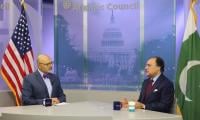KARACHI: The country’s tax-to-GDP ratio inched down to 12.5 percent in the fiscal 2016/17 from 12.6 percent in the previous fiscal year, SBP said in its annual report on Thursday.
The central bank, in state of the economy report, said the tax and administrative reforms implemented during the last few years led to growth in tax collection, which had consistently been higher than the nominal GDP growth.
“The reforms resulted in the tax-to-GDP ratio rising to 12.6 percent in 2015/16 from the low of 9.3 percent in 2010/11,” it added.
“This performance, however, could not be sustained in 2016/17.” The SBP, however, said the ratio is still one of the lowest in the region except Bangladesh. The central bank further said the tax-to-GDP ratio was even lower than the target of 13.6 percent for FY17.
“Moreover, it fell far short of the 15 percent benchmark envisioned in the National Finance Commission (NFC) award 2009,” it said. NFC award expected both the federal and provincial governments to step up efforts to increase the tax-to-GDP ratio to 15 percent by 2014/2015 with an emphasis that the provinces initiate steps to mobilise effectively revenue through taxing agriculture and real estate sectors. The ease in tax to GDP ratio warrants a deepening of structural reforms, both by the federal and provincial governments.
“As the tax on agriculture and services sectors has become a provincial matter following the 18th amendment, provincial governments need to bring the largest contributions to GDP,” the central bank added. The SBP stressed need to address the structural issues in the taxation system, such as narrow base and heavy reliance on withholding taxes. The central bank said growth in revenue collection by the Federal Board of Revenue fell to 8 percent in 2016/17 from 20 percent achieved in the preceding fiscal year.
“The deceleration was broad-based, as growth in both direct and indirect tax
collection was much lower as compared to 2015/16,” it added. “The focus of direct taxes continues to remain narrow, largely relying on withholding tax from salaried class and corporate sector, despite several rounds of reforms.” The situation becomes even more complicated when existing taxpayers have to share the additional burden of foregone taxes due to tax incentives, it added.
This initiative enables them to earn a dignified livelihood for their families
The event will host more than 700 booths, including leading global and Pakistani tech giants
Gold rates increased by $8 to all-time high rates of $2,371 per ounce in the international market
Strong retail sales prompted economists at Goldman Sachs to boost their gross domestic product
The IMF dictates its terms based on our past performance
Goldman's profit rose 28 percent to $4.13 billion, or $11.58 per share, in the first quarter







